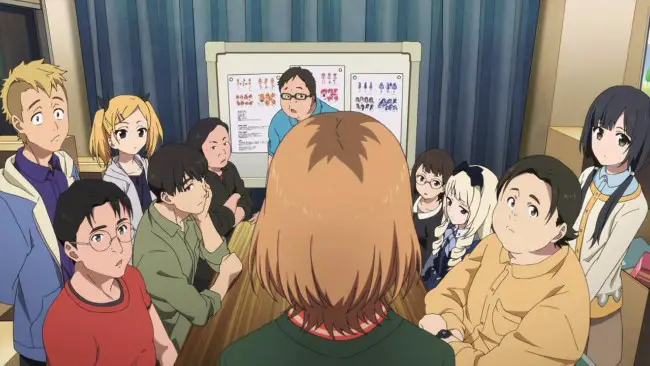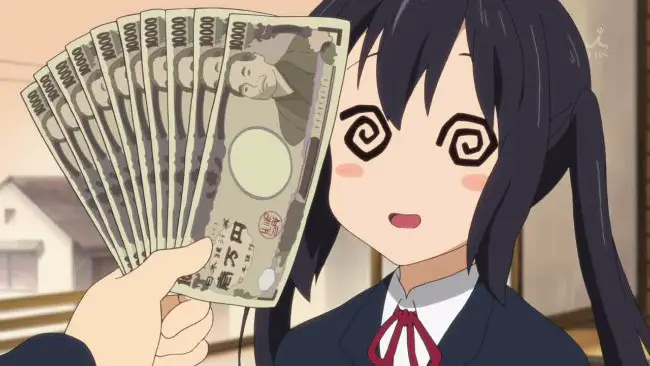How Does Anime Make Money In Japan
How practise anime studios brand money? We run into reports coming out stating that the industry is posting record high revenues, merely they take followed by reports of studios struggling to pay their animators above minimum wage.
It's a complex and easy answer! The simplified answer is that studios don't share in the all of the acquirement that product committees brand.
Now for the complex answer…
Production Committees

Production committees are heavily talked nearly merely are rarely understood by the community. For many fans, there is a mysterious air about production committees sort of like puppet masters. Earlier diving into how studios generate revenue, we need to briefly examine the structure of the committee organisation.
Committees are pretty unproblematic – a grouping of entertainment companies comes together to fund an anime serial. Every member specializes in a different expanse such equally marketing, distribution, or merchandising and split the production costs. Keep in listen that production costs are not evenly split, which means sure members can brand more coin off of an anime'south success.
Additionally, not all members receive money from the aforementioned revenue streams. For example, anime producer Marina Sasaki (Barakamon/ Parasyte -the maxim-) said that anime studios don't get a huge chunk of merchandise sales. A studio might see a few hundred thou yen per i million yen in merchandise sales.
Also, not all studios accept a seat on production committees, which can limit their potential turn a profit. Toei Blitheness, Studio Pierrot, Kyoto Animation, Sunrise, Studio Bone, and P.A. Works are amid the few anime studios to be on committees.
Animation Costs

Nigh anime studios are contractors. Meaning, the production committee puts together a budget and hires a studio to work on the anime. Typically a studio doesn't get to cull the anime they work on but are paid upfront for the work.
A tardily night anime can cost $5 meg USD to produce, and that money has to exist stretched to pay everyone working on the project. One of the reasons animators have depression wages is due to the product and sheer corporeality of animators employed with some projects having over 100 artists!
Of course, studios exercise manage their finances. They effort to save profits from past hits to help pay their employees or outsource to other studios if information technology'southward cheaper.
Allow's await atThe Ancient Magus' Brideas an example. Wit Studio is credited with producing the anime's beautiful blitheness and is praised for the serial' consistent look. They aren't the only studio working on the hit anime:
- Anitus Kobe – 2nd animation / in-between blitheness
- Wish – second animation / finish animation
- Bamboo – backgrounds
- Sublimation – CGI
- Jay Film – animation editing
- Asahi Production – finish blitheness / in-betwixt animation
- D-COLORS – finish animation
- DEFA – cease animation
- RIC – finish animation / in-between animation
- SILVER LINK – cease animation
- Studio 4ºC – finish blitheness
- Studio Elle – terminate animation
- A-Line – in-between blitheness
- Bending – in-betwixt animation
- FAI International – in-betwixt animation
- ingresA – in-between animation
- Nakamura Production – in-between animation
- Production Reed – in-between animation
- Rising Forcer – in-between blitheness
- SDM – in-between animation
- Snow Light Staff – in-between animation
- Studio Gimlet – in-betwixt animation
- Studio Mu – in-between animation
- Studio µ – in-between animation
- Asura Pic – line test
- T2 Studio – photography
- Team Taniguchi – special effects
28 anime studios are collaborating onThe Aboriginal Magus' Brideand y'all've probably haven't heard of most of them. Again, the 5 1000000 budget (assuming the series has boilerplate funding) has to be spread among those studios. Not all studios volition go an even split and they take different salary rates for their artists.
This is a factor that tends to get overlooked when talking most anime product. It's a collaborative try amid a variety of studios and they are needed if an anime is to air on fourth dimension.
Then, how practice studios make money later producing a series?
The Importance of Discs

Home video is still vital for blitheness studios. Production committees and studios will rarely if ever comment on revenue splits, simply it's been implied that home video is extremely important for an anime studio's lesser line.
Discs sales have as well been falling in Japan every twelvemonth since 2005, meaning that this revenue stream is drying upwards. This is one of the reasons anime is and so expensive to purchase in Japan. The studios are trying to make up for the lack of quantity sold at high prices.
Digital sales of anime series are also down, highlighting that fans don't feel a need to own their favorite anime. However, these sales are still relied upon by studios to aid cover their costs, which has led to 25% of all studios reporting a net loss of profits.
The Importance of International Licensing
It tends to disharmonism with the "international fans don't matter" narrative people dearest to peddle, but international licensing has go the life-blood of anime.
In 2015, licensing was the second largest revenue stream for the industry. This includes legal streaming and purchasing localized home video releases.
Licensors don't report the acquirement splits (and they have no reason to), merely a portion of it does go dorsum to animation studios.
Other acquirement streams for studios include theatrical releases, producing animation for pachinko, and pocket-size portions of trade sales.
The Upshot of Piracy

Piracy isn't a zilch-sum issue that tin can be hands solved. In fact, various bookish studios from contained agencies take constitute that piracy has a minuscule effect on sales numbers for near industries since not all revenue streams can be pirated.
However, academics do concord that piracy hurts home video sales, which is what studios rely on. The availability of pirated streams or torrents too hurts legal streaming services due to a toll advantage equally most people volition choose free instead of paying. The outcome is trying to identify a real sticker price on the amercement, which is covered in a Ted Talk about music piracy.
It's incredibly simplistic to boil piracy down since there are a lot of uncontrollable variables such as assuming all pirates are potential customers and regional availability. This is why many academics label piracy "problematic," simply not an actionable threat due to the lack of controlled studies.
In the end, you should always try to legally support the arts and entertainment when you can.
Anime Industry Growth, but Lack of Studio Profits
How is that the anime industry posted a tape 2 trillion yen revenue line, but anime studios are struggling to pay their artists? It'south because the actual anime itself isn't assisting.
The industries 3 largest revenue streams are merchandising, international licensing, and anime-themed pachinko machines.
The three lowest revenue streams are Japanese home video, Japanese digital distribution, and anime related music sales.
Observe the trend? Auxiliary segments rake in the cash, whereas the anime itself doesn't gross enough for studios.
The challenge is trying to increment these acquirement segments, which do have a large piracy rate. This is why so many studios and bureau try to educate anime fans about piracy.
Source: https://myotakuworld.com/how-anime-studios-make-their-money/
Posted by: yearbywartime.blogspot.com

0 Response to "How Does Anime Make Money In Japan"
Post a Comment